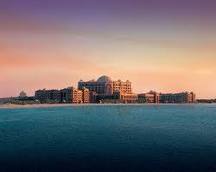Lebanon has a fascinating and complicated history full of many overlapping cultures and religions that are visibly evident, even on such a short visit. Its geographical location, where East meets West on the edge of the Mediterranean Sea, and fertile Bakaa valley have made it a desirable land for millenia. Evidence of civilizations dates back 7,000 years and include the Phoenicians, Persians, Romans, Syrians, Arabians, and Ottomans. Current religions present in the area, noted by places of worship and distinctive clothing, include the Shia, Sunni, Greek Orthodox, Christian Maronite, and the curious Druze. Common languages spoken today are Arabic, French, and English. Many Lebanese switch easily from one language to the other, frequently blending all the languages into the same conversation.
Unlike Abu Dhabi, which is a very new city, Beirut is old and full of character. It has been called the Paris of the Middle-East, which is understandable due to its colonial architecture and vibrant neighborhoods. But bullet holes are everywhere, remnants of the civil war from 1975-1990 and the 2006 war between Israel and Hezbollah. The downtown area has been beautifully gentrified, with high end shops and new buildings in tones of ochre, designed to compliment older restored buildings. The renovation is largely due to the financing of billionaire Rafir Hariri, the prime minister of Lebanon that was assassinated in Beirut in 2005. Despite tensions, Lebanon is recovering from its most recent battles and is working hard to restore its image. Its efforts have paid off: in 2009, a New York Times poll voted Beirut as the #1 top tourist destination.
The roads of Lebanon are full of old cars that get beat up on a regular basis due to cavalier driving habits. While having breakfast at a corner cafe our first morning there, we were admiring a funky looking dune buggy driving down the street when it intentionally backed into the car behind it - twice. Apparently there was an argument over a parking space. But this is totally acceptable behavior in Lebanon. Many cars, including our driver's car, have extra heavy duty metal bumpers applied to the regular bumpers. Red lights? Completely optional. That solid double yellow line down the middle of the road? That's the line you straddle to pass slower traffic, even if there's a blind curve ahead of you or another car is doing the same thing in the opposite direction. I can safely say driving in Lebanon is the unsafest I have ever seen in the world.
Our weekend included a day trip through the Lebanese Mountains and into the Bakaa Valley. If Beirut is the Paris of the Middle-East then the Lebanese Mountains should be considered the Italy of the Middle-East. The scale and colors are strikingly similar. The hillsides are tiered for grape vines and other crops. Numerous ancient hill towns dot the landscape. We visited one partiularly picturesque town called Deir El Qamar, known as the Village of Princes due to the many Lebanese aristocrats that were born there. We made a brief stop at a much more recent quirky castle that was built by a man in an unsuccessful attempt to win the heart of a woman he loved. Further up the road, we stopped by the Beit ed Dine Palace, built by a local emir starting in 1788 and full of beautiful gardens, waterworks, inlaid stone floors, and inlaid wood walls and ceilings. Moving higher up into the mountains, we hiked through the famous cedars of Lebanon with vistas of the valley that we had just crossed. On the other side of the mountain pass we got views of the lush Bekaa valley. We ate a very pleasant late Lebanese lunch at a restaurant called the Seven Eyes in a garden setting surrounded by the fruit and vegetable crops of the region. Our final stop was at the Kafraya Vinyard with grounds on par with what you might find in Napa Valley. Our day ended with a white-knuckle return trip over the mountains and back to Beirut.
We thoroughly enjoyed our weekend in Lebanon, even though our visit was brief. The weather was sunny and a refreshing 75 degrees. The scenery was beautiful. If we had more time I would have loved to visit one of the many coastal resorts, the Roman ruins of Baalbek, or the ancient town of Byblos. But those will have to wait for another time. Maybe we can combine those sites with a winter ski trip in the Lebanese Mountains.
Matthew and John, before the dune buggy incident
Typical old colonial building being restored
Combination of old and new buildings
Pedestrian friendly downtown
Bullet holes are everywhere
Deir el Qamar
The Castle of Unrequited Love
Detail
Making minutia at Al Almira, Beit ed Dine
Beit ed Dine Palace
Beit ed Dine Palace
The Cedars of Lebanon

Top of the World

Top of the World, II

Bekaa Valley with view of Qaraaoun Lake
Late lunch at the Seven Eyes














Very cool! Have you had occasion to use your French in the Middle East yet?
ReplyDelete